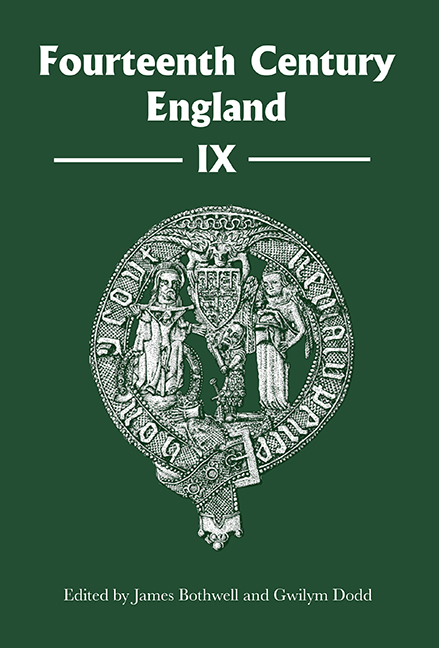Book contents
- Frontmatter
- Contents
- List of Illustrations
- Contributors
- Preface
- Abbreviations
- The Death of Edward II Revisited
- Living in the Shadows: John of Eltham, Earl of Cornwall (1316–36)
- Careers of the Lesser Parochial Clergy Before the Black Death
- Heritage and Symbolism: the Romans and Tanners in Fourteenth-Century York
- ‘Let Them Realize What God Can Do’: Chivalry in the St Albans Chronicle
- Historical Writing in the North-West Midlands and the Chester Annals of 1385–88
- High-Status Execution in Fourteenth-Century Ireland
- Traitor to the Chose Publique: Negotiating Constitutional Conflict Through the Law of Treason 1399–1402
- Notes and Documents – A Letter from Chatton: the Date and the Writer
- Fourteenth Century England Issn 1471–3020
Heritage and Symbolism: the Romans and Tanners in Fourteenth-Century York
Published online by Cambridge University Press: 07 May 2022
- Frontmatter
- Contents
- List of Illustrations
- Contributors
- Preface
- Abbreviations
- The Death of Edward II Revisited
- Living in the Shadows: John of Eltham, Earl of Cornwall (1316–36)
- Careers of the Lesser Parochial Clergy Before the Black Death
- Heritage and Symbolism: the Romans and Tanners in Fourteenth-Century York
- ‘Let Them Realize What God Can Do’: Chivalry in the St Albans Chronicle
- Historical Writing in the North-West Midlands and the Chester Annals of 1385–88
- High-Status Execution in Fourteenth-Century Ireland
- Traitor to the Chose Publique: Negotiating Constitutional Conflict Through the Law of Treason 1399–1402
- Notes and Documents – A Letter from Chatton: the Date and the Writer
- Fourteenth Century England Issn 1471–3020
Summary
The fourteenth-century visitor to York, entering the city from the south, would have passed underneath an archway that reused Roman stones and sarcophagi. Continuing into the city, they would have seen a minster built on the site of the principia of Roman York, the remains of Roman fortifications around the city, Roman material prominently displayed in one of the main marketplaces as a symbol of a legendary king of York, and Roman stones in many of the churches of the city. Despite this concentration of antique material, York was not unusual; Roman stones were reused across medieval England. A sense of the past, the ways in which churches were used to convey social, political and religious meaning, and the effect of famine and plague on urban culture are all discussed below, along with the condition of York in the fourteenth century. To do this, the reuse of Roman material will be explored in one York parish church, namely All Saints North Street. This church was closely associated with the tanners of the city, and it will be argued that the use of Roman stone shows that these parishioners were especially keen to identify with the past. The focus on one church will allow an examination of how Roman stone was an integral part of the development of the building and will add to other studies that show how history and heritage were important factors in the construction, design and decoration of medieval buildings. This discussion will also add to previous work on the reuse of Roman material in medieval York where this material has frequently been used to explore the priorities of (early and high) medieval builders.
The parish church of All Saints North Street still stands on the south-west bank of the River Ouse, in the Micklegate neighbourhood of York (Figure 1). In the fourteenth century, it was neither amongst the richest nor the poorest parishes in the city and had an average number of parishioners compared to other parishes. The parish was home to several mercantile families during the fourteenth century, but for most of this period it was dominated by the tanners of York (over 60 per cent of the population in 1381).
- Type
- Chapter
- Information
- Fourteenth Century England IX , pp. 67 - 86Publisher: Boydell & BrewerPrint publication year: 2016



